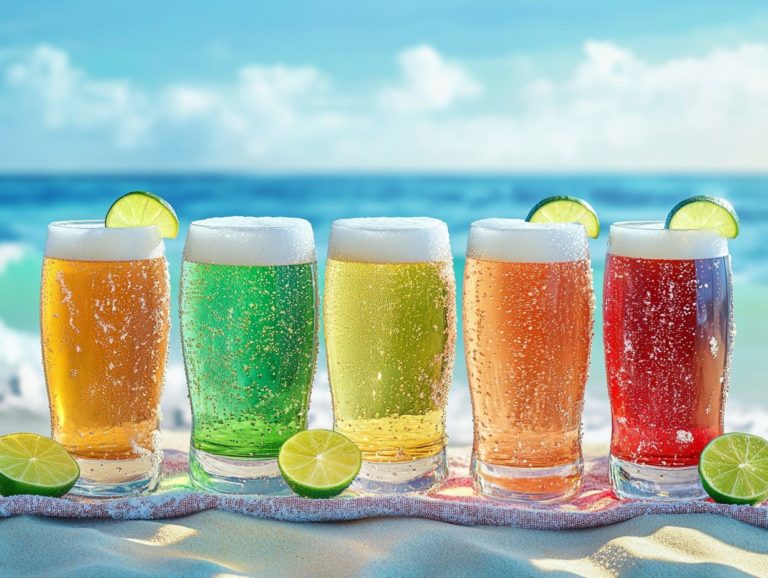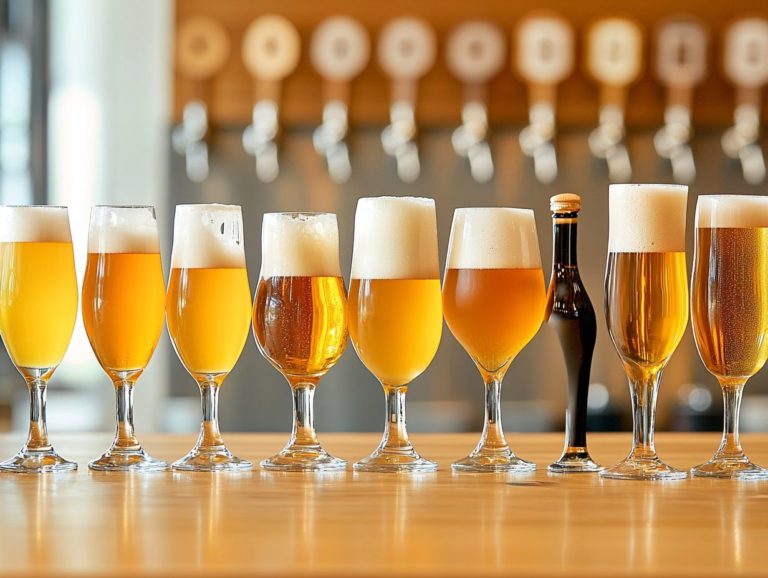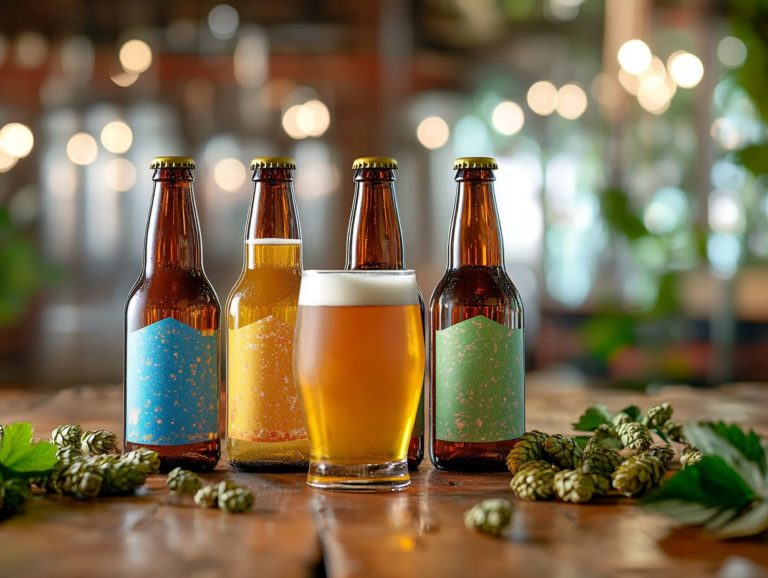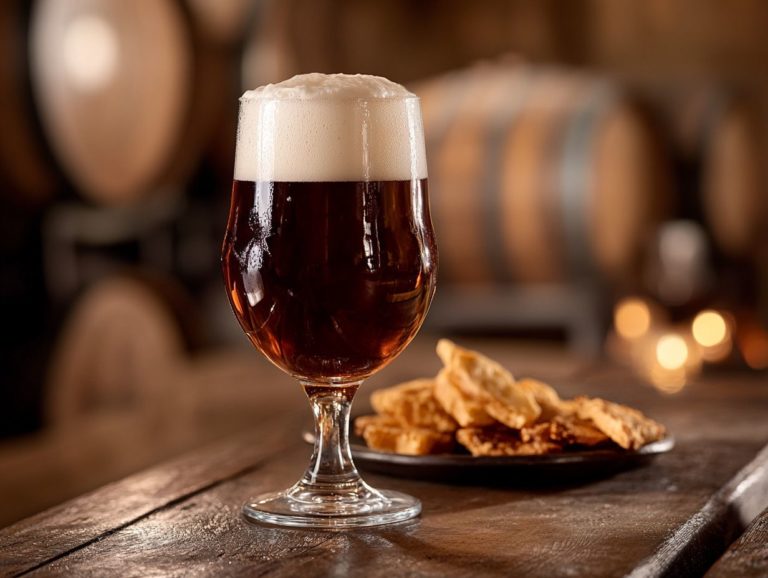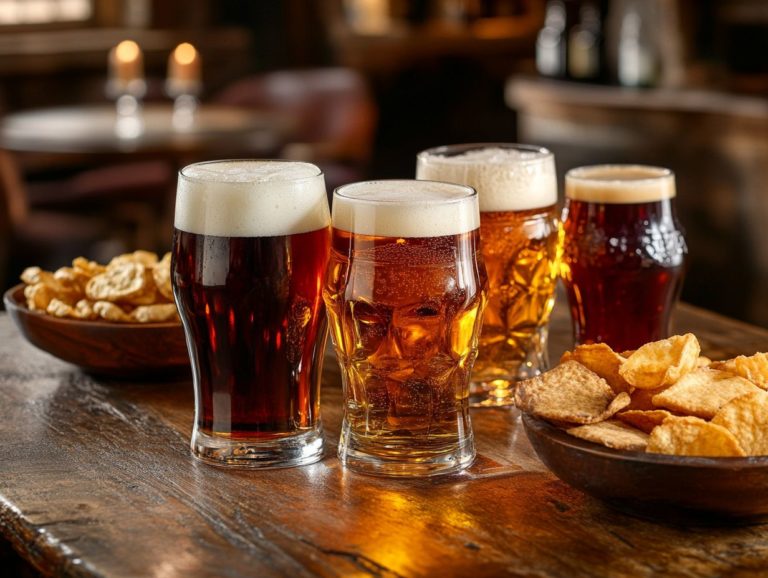Top 10 Beer Styles for Craft Beer Newbies
Contents
- Discover the World of Craft Beer
- Exploring Craft Beer Styles
- 3. Wheat Beer (Wheat)
- 4. Stout (Stouts)
- 5. Pilsner (Light Lagers)
- 6. Belgian Ale (Belgian Ale)
- 7. Amber Ale (Lagers)
- 8. Porter (Porters)
- 9. Sour Beer (Sours)
- 10. Brown Ale
- What Makes Craft Beer Different from Traditional Beer?
- Frequently Asked Questions
- What are the top 10 beer styles for craft beer newbies?
- What is the difference between craft beer and regular beer?
- Which beer style is best for someone who doesn’t like bitter beers?
- What is the alcohol content of these top 10 beer styles for craft beer newbies?
- Are there any gluten-free options among the top 10 beer styles for craft beer newbies?
- What food pairings go well with these top 10 beer styles for craft beer newbies?
Discover the World of Craft Beer
Craft beers have truly revolutionized the beverage landscape, presenting an enticing selection of flavors and beer styles that cater to both seasoned enthusiasts and curious newcomers alike.
As you embark on your craft beer journey, consider exploring the top 10 beer styles perfect for beginners. From the invigorating notes of Pale Ale to the rich complexities of Stouts and Porters, each style promises a unique and delightful experience.
You will also delve into how these styles set themselves apart from traditional beers, highlighting key characteristics to look for, brewing methods, and offering suggestions for perfect food pairings.
Get ready to elevate your tasting experience now! Here s to raising a glass and discovering your new favorite brews!
Key Takeaways:
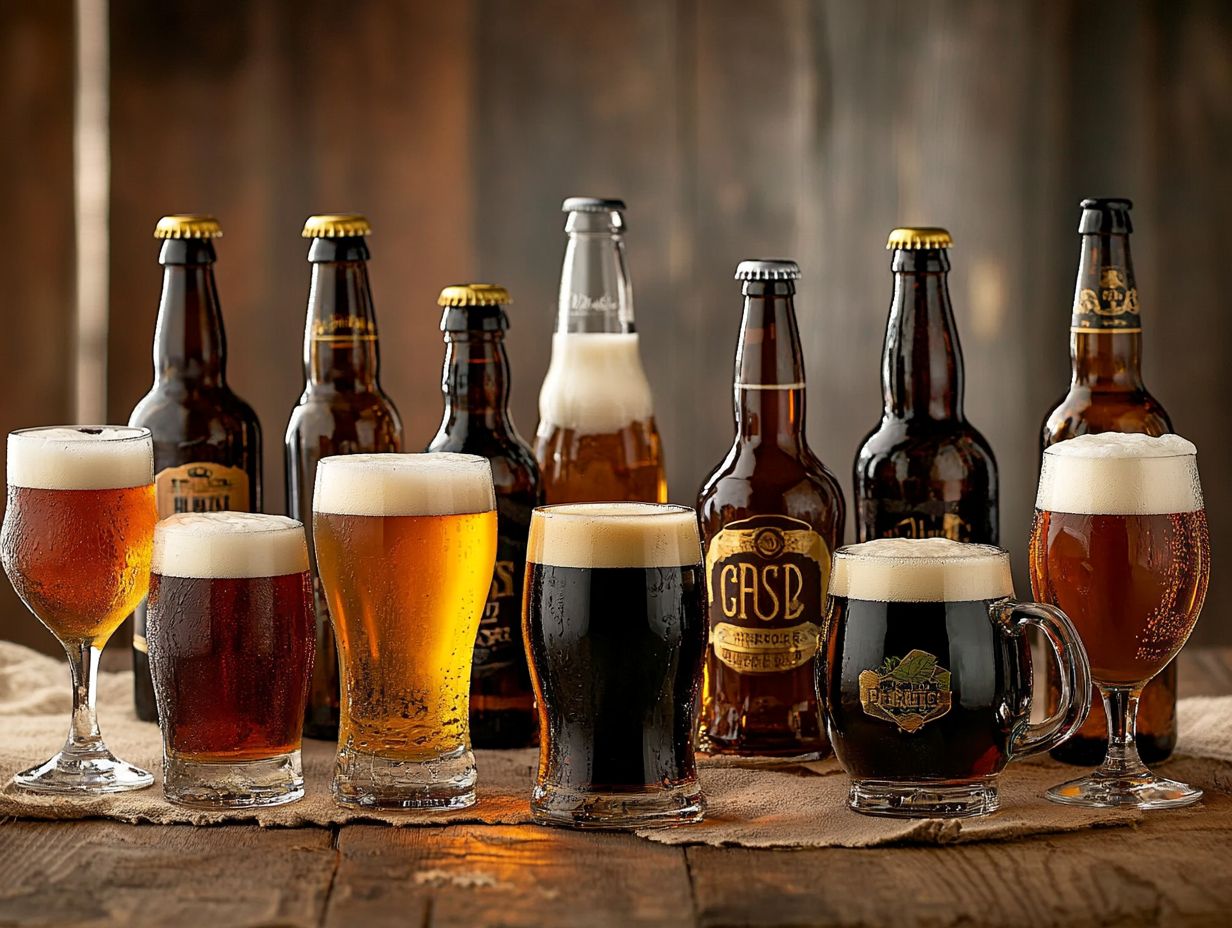
- Start with a Pale Ale or Wheat Beer for a lighter and more approachable craft beer experience.
- For those who enjoy hoppy and bitter flavors, try an IPA or Belgian Ale, particularly the American IPA for its piney flavors.
- Expand your palate by trying different beer styles and experiment with food pairings for a unique and enjoyable experience.
1. Pale Ale
Pale Ale, a true gem in the realm of craft beers, presents a delightful balance of malt and hops. Its floral hoppiness, combined with an approachable alcohol content, makes it a favorite among beer enthusiasts. Originating in the United Kingdom, this beer style has undergone a transformation, paving the way for American interpretations such as the American Pale Ale.
With its citrusy, fruity notes and refreshing finish, this beer is remarkably versatile, perfect for any occasion you might have in mind.
Pale Ale stands out for its ability to please a wide range of palates, earning its rightful place as a staple in breweries across the nation.
The origins of Pale Ale date back to the 1700s, when it was brewed using pale malts that were kiln-dried, resulting in its signature lighter color. Over the years, brewing techniques have evolved, introducing hops that enhance flavors and extend the beer’s shelf life.
Unlike the intensely bitter American IPA, which often features assertive hop varieties, or the smooth and creamy Cream Ale known for its easy-drinking quality, Pale Ale strikes a harmonious balance that appeals to many craft beer enthusiasts.
Its unique ingredients, such as caramel malts, contribute to its distinct character, often bringing forth notes of toffee and biscuit. Brewers experiment with regional hops, creating a dynamic range of flavors that keep craft beer fresh.
This adaptability has been pivotal in the craft beer movement, ensuring that Pale Ale remains relevant and continues to celebrate innovation in craft beers and brewing.
2. India Pale Ale (IPA)
India Pale Ale (IPA) is a vibrant and hop-forward beer style that captures attention with its intense floral hoppiness and intricate flavor profile, making it a premier choice among craft beer enthusiasts and those exploring beer styles.
This exceptional brew has its roots in the 19th century, when British colonial brewers ingeniously added extra hops to ensure their beer survived the long journey to India.
Over time, the IPA has evolved dramatically, transitioning from a simple pale ale into a diverse range of sub-styles, including the much-adored Double IPA, which features even bolder hop flavors and a higher alcohol content with unique flavors.
The brewing techniques employed, such as dry hopping when hops are added during fermentation to enhance aroma and flavor without increasing bitterness play a pivotal role in amplifying its hoppy characteristics. This delivers an array of taste sensations that can range from zesty citrus to earthy pine.
Additionally, the choice of local ingredients can significantly shape the flavor profile, enabling brewers to craft unique interpretations that showcase the unique characteristics of the local environment and their beer knowledge.
As you explore the rich world of craft beer, consider sharing your experiences and favorite styles with the craft beer community!
Exploring Craft Beer Styles
3. Wheat Beer (Wheat)
Wheat Beer is a light and refreshing craft beer style that you ll absolutely love for its enjoyable taste, often brewed with a generous amount of wheat. This results in a unique flavor profile that is both smooth and creamy, elevating your tasting experience and making it one of the common craft beers.
Within this delightful category, you ll encounter varieties like Hefeweizen, which dazzles the palate with notes of banana and clove.
Belgian Witbier often features spices such as coriander and orange peel. Local ingredients enhance the aroma and character of each brew.
The use of brewing techniques passed down through generations helps preserve the authenticity of these beers.
For example, Hefeweizen typically undergoes a fermentation process designed to highlight its fruity and spicy notes, while Belgian Witbier may involve a meticulous mashing process coupled with the addition of citrus peels, profoundly influencing the final flavor. These thoughtful techniques contribute to the overall complexity of wheat beers, making them a beloved choice among craft beer aficionados.
4. Stout (Stouts)
Stout is a rich and full-bodied craft beer style that captivates the senses with its dark color and robust flavors. You ll often find delightful notes of coffee, chocolate, and caramel woven together, creating a complex tasting experience that leaves a lasting impression, similar to porters but with distinct differences.
This beloved beer style traces its roots back to the 18th century, evolving through a variety of regional interpretations. From Dry Stout, famously embodied by iconic brands, to Imperial Stout, which boasts a higher alcohol content and an intense flavor profile, each variant offers its own unique charm reflective of different brewing methods.
Brewing techniques like using roasted barley and unique fermentation processes shape these distinct flavors.
Local craft breweries, particularly those nestled in Vermont and Oregon, often push the envelope with innovative recipes. They incorporate local ingredients like artisanal coffee or gourmet chocolate, ensuring that each stout tells a story reflective of its origin.
The passion and creativity of these brewers fuel the ever-growing popularity of this exceptional beer style, inviting you to explore a world of flavors with every sip!
5. Pilsner (Light Lagers)
Pilsner is a classic light lager that you will come to appreciate for its perfectly balanced bitterness and crisp finish. It s the refreshing choice that craft beer enthusiasts often seek when they want something easy drinking, light, and refreshing.
Originating in the Czech city of Plze in the mid-19th century, Pilsner arose from the desire for a light beer brewed at cooler temperatures that would starkly contrast with the darker brews of its time. The marriage of Saaz hops and soft water creates that signature flavor, paving the way for various interpretations, including German and American Pilsners.
The brewing techniques, particularly the extended lagering phase, contribute to its exceptional clarity and smoothness. When compared to hop-forward styles like Pale Ales and IPAs, which often steal the spotlight with their bold flavors and aromas, Pilsner makes its mark with a refreshing and subtle character. It appeals to those who truly appreciate a delicate balance in their brews, making it a popular choice in light lagers.
6. Belgian Ale (Belgian Ale)
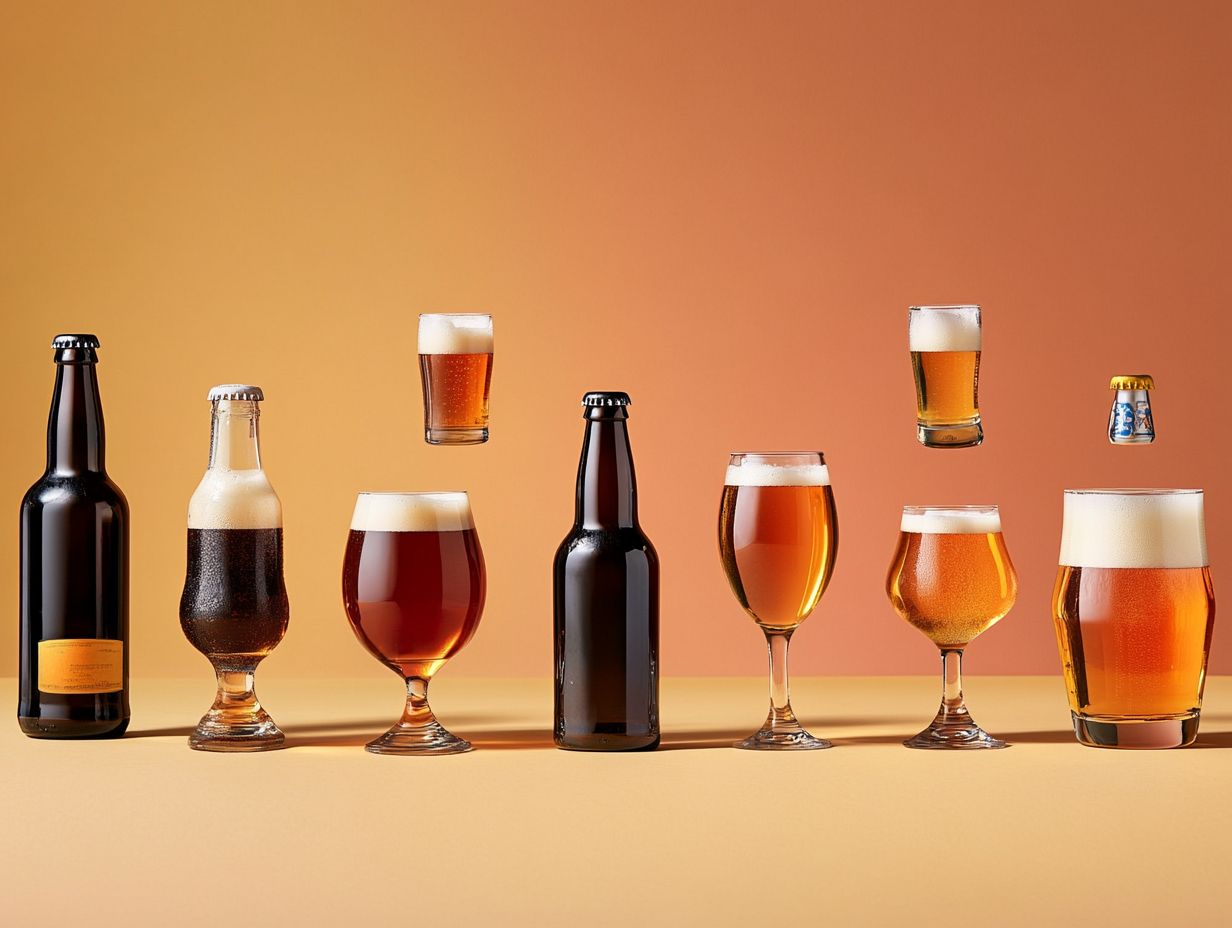
Belgian Ale encompasses a captivating array of craft beer styles. Each is known for its delightful fruity and spicy flavors, crafted through unique fermentation processes and the use of locally sourced ingredients.
It’s a great addition to any craft beer guide. This is especially true for those looking to expand their beer knowledge.
Consider the elegance of styles like Abbey Dubbel and Belgian Tripel, which truly showcase the complexity within this category. The Abbey Dubbel greets you with its rich malty sweetness, often revealing enticing notes of caramel and dark fruits. In contrast, the Belgian Tripel offers a lighter experience, with a golden hue and a spicy, fruity character that typically features hints of banana and clove.
The various yeast strains used in the brewing process are essential to building these distinctive profiles. They contribute to the formation of esters, which are compounds that create fruity flavors, and phenols, which contribute to spicy notes that define each style. Barrel aging plays a pivotal role in the Belgian brewing tradition, enhancing flavors and imparting subtle wood and vanilla nuances that elevate the overall tasting experience.
Discover breweries that specialize in Belgian Ales! Nick s of Calvert and Silos Brewing Company are examples of places where you can find expertly crafted Belgian Ales.
7. Amber Ale (Lagers)
Amber Ale is a versatile craft beer style that perfectly balances malt and hops, presenting a rich amber hue and a flavor profile that can traverse from caramel sweetness to mild bitterness.
This multifaceted beer style is crafted through various brewing techniques, such as the precise addition of toasted malts or a careful selection of hops that allow both aroma and bitterness to shine through. Unlike IPAs that focus on hops, Amber Ales provide a more rounded flavor experience, appealing to those who appreciate a complex yet approachable brew with balanced bitterness.
Local breweries often shine in their production of exceptional Amber Ales, with many known for their unique twists on classic recipes. For instance, microbreweries might utilize locally sourced honey or seasonal spices, resulting in distinctive variations that beautifully reflect the region’s brewing heritage.
The small breweries in places like Raleigh, NC, highlight the creativity and innovation in crafting these ales.
8. Porter (Porters)
Porter is a captivating and robust craft beer style that stands out with its full-bodied mouthfeel and complex flavor profile, often revealing delightful hints of chocolate, coffee, and roasted malt. This makes it a fascinating style for those interested in exploring beer styles.
Originating in the bustling streets of London during the 18th century, this intriguing style has undergone significant evolution, leading to the emergence of various subtypes like Robust Porter and Baltic Porter. Robust Porters are celebrated for their rich, intense flavors, frequently amplified by higher alcohol content and a pronounced roasted character. Conversely, Baltic Porters, which found their calling in Eastern Europe, utilize lager yeast, offering a smoother and cleaner finish.
Other noteworthy subtypes include American IPA and Double IPA, known for their bold hop profiles and strong flavors.
Discover breweries that specialize in Porters! Breweries such as Founders Brewing Co., Bell’s Brewery, and Nick s of Calvert engage in meticulous brewing practices that showcase the intricate dance between malts and hops. They push the boundaries of flavor while paying homage to the rich heritage of this remarkable style, inviting you to savor every sip. Notable breweries such as Silos Brewing Company and Dogfish Head 90 Minute IPA further exemplify the creativity and expertise within the craft beer community.
9. Sour Beer (Sours)
Sour beer presents an innovative and captivating craft beer style. It derives its unique tartness from wild yeast strains and bacteria, resulting in a refreshingly complex tasting experience that invites exploration.
Within the realm of sour beer, you’ll encounter a variety of sub-styles. Berliner Weisse is known for its low alcohol content and bright, lemony acidity. In contrast, Lambics are often aged in wooden barrels, showcasing a delightful array of fruity and funky flavors. The fermentation techniques play an important role; for instance, Lambics undergo spontaneous fermentation, which means they ferment using the wild yeast and bacteria present in the brewing environment. This process imbues the beer with a character deeply connected to its region.
Using local ingredients, like seasonal fruits and grains, can significantly shape the final profile, highlighting the artistry and craftsmanship that goes into sour beer production.
10. Brown Ale
Experience the rich, nutty profile of Brown Ale a craft beer that tantalizes your taste buds! It captivates your palate with its malty and flavorful characteristics, striking a delightful balance between sweetness and bitterness in a full-bodied mouthfeel that many beer enthusiasts find irresistible.
Among the variations, English Brown Ale shines with caramel sweetness and delightful hints of toffee and chocolate, typically presenting a more restrained hop character. For those who prefer a lighter option, Cream Ale might be the perfect choice, offering a balanced and smooth flavor profile. On the other hand, American Brown Ale boldly asserts itself with a more pronounced flavor profile, featuring a stronger hop presence alongside that robust malt backbone, often delivering hints of citrus or pine.
Renowned breweries like Brooklyn Brewery and Sierra Nevada excel in crafting exceptional Brown Ales. Each employs distinct brewing techniques that illuminate the unique interplay between malt and hops. These variations elevate your tasting experience and invite you to explore the diverse landscape of this beloved beer style.
What Makes Craft Beer Different from Traditional Beer?
Craft beer distinguishes itself from traditional beer through its focus on unique flavors, innovative brewing methods, and the incorporation of local ingredients. This creates a vibrant array of styles that appeal to discerning tastes.
This distinction underscores the importance of small breweries, which prioritize quality over quantity. Unlike their larger counterparts, these craft brewers are dedicated to experimenting with new ingredients and techniques, producing distinctive brews that embody their local culture and community.
As you delve into the diverse world of craft beer, gaining a deeper understanding of the brewing process and ingredients becomes essential for fully appreciating each creation. This knowledge elevates your enjoyment and connects you to the craftsmanship and passion that go into every pint, enriching your experience and deepening your appreciation for the artistry of brewing.
What Are the Key Characteristics of Each Beer Style?
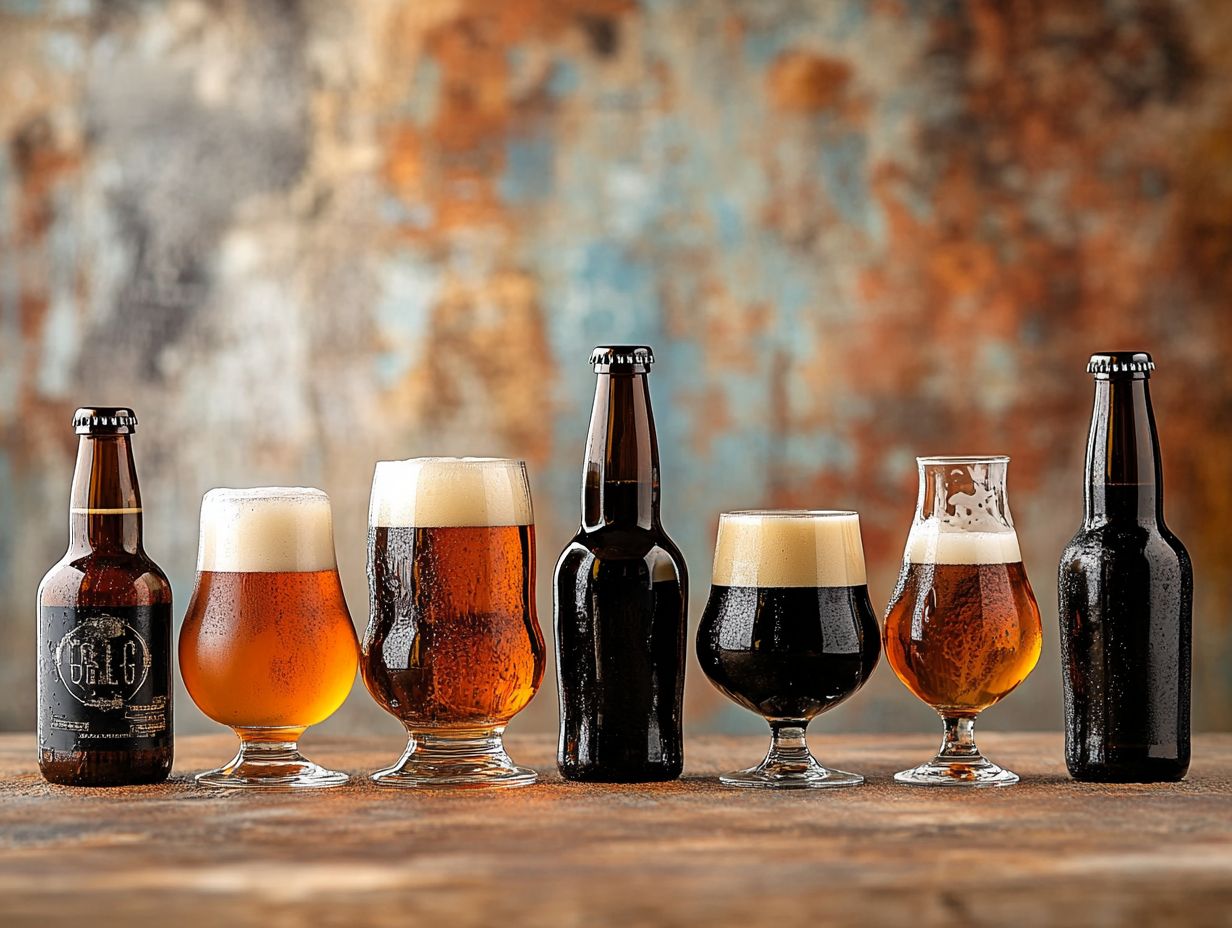
Each beer style has its own distinct characteristics that shape its taste, aroma, and appearance, influenced by a variety of factors such as ingredients, brewing methods, and alcohol content.
Take IPAs, for example; they are renowned for their hoppy aroma and robust bitterness, often complemented by delightful notes of citrus and pine. On the flip side, stouts are usually rich with roasted flavors, bringing to mind hints of chocolate and coffee. You ll notice that the color of these beers can vary significantly as well; IPAs typically boast a golden to amber hue, while stouts often present an almost impenetrable black.
Mouthfeel is another crucial element that contributes to your overall sensory experience. IPAs generally offer a light to medium body, while stouts tend to deliver a heavier, creamier texture. Exploring popular craft options like a West Coast IPA or an Irish stout can deepen your appreciation for these unique attributes and elevate your beer-tasting journey.
Which Beer Styles Are Best for Different Palates?
Beer styles present a variety of options catering to a diverse range of palates, ensuring there s something for everyone from light and refreshing options that welcome newcomers to the craft beer scene, to bold and intricate flavors that seasoned enthusiasts savor.
This remarkable diversity invites you on a flavorful journey, allowing you to uncover your preferences as you navigate the rich landscape of brewing. As a beginner, you might delight in crisp lagers or smooth wheat beers, which serve as an inviting gateway into the world of craft brews. For the more adventurous, experimenting with the profound flavors found in IPAs or stouts could be a thrilling experience, often revealing delightful notes of coffee, chocolate, or citrus.
By exploring these various styles, you not only elevate your palate but also immerse yourself in the vibrant craft brewing community, enriching your overall experience in the process.
What Are the Most Popular Craft Beer Styles?
Some of the most popular craft beer styles that you’ll encounter include American IPAs, Stouts and Porters, and Wheat Beers. Each of these styles showcases unique flavors and characteristics that cater to a wide range of palates.
These styles are celebrated for their distinct qualities. For instance, American IPAs are renowned for their bold hop flavors and aromatic profiles, making them a go-to choice for those who appreciate a hoppy kick. Stouts offer a rich tapestry of roasted malt flavors and creamy textures, wrapping you in a warm hug of flavor. Meanwhile, Wheat Beers shine with their fruity and refreshing notes, perfect for sipping during those sun-soaked days.
Notable breweries such as Stone Brewing are champions of IPAs, Guinness has mastered the art of Stouts, and Allagash Brewing stands out for its exceptional Wheat Beers each exemplifying the craft of brewing at its finest.
As your preferences shift and evolve, you might notice a growing trend towards sessionable beers and sour ales, reflecting a desire for refreshment that doesn t overwhelm. This trend further diversifies the craft beer landscape, inviting you to explore new and exciting flavors.
How Can One Expand Their Palate and Try New Beer Styles?
Expanding your palate and exploring new beer styles can be an exhilarating journey, inviting you to dive into the diverse flavors and rich brewing traditions that craft beer has to offer.
To truly savor the art of craft brewing, why not attend local beer tastings where fellow enthusiasts come together to share their insights on different brews? Visiting local breweries provides invaluable insights into the brewing process and lets you sample fresh creations straight from the source.
Don t underestimate the power of food pairings to elevate your tasting experience; for instance, a hoppy IPA can perfectly complement a spicy dish, while a rich stout can create magic with chocolate desserts.
Keeping an open mind is absolutely essential embrace the unexpected, and you just might stumble upon a new favorite style that delights and surprises you.
What Are Some Tips for Pairing Craft Beer with Food?
When pairing craft beer with food, consider the different types of beer, such as Lagers and India Pale Ale (IPA), to find the perfect balance.
Pairing craft beer with food has the power to elevate your dining experience, enhancing the flavors of both the beer and the meal through thoughtful combinations that highlight unique tastes.
Understanding the principles of balance and contrast is essential to mastering this delightful art. For example, a hoppy IPA can cut through the richness of a creamy cheese, while a malty stout beautifully complements the sweetness of desserts.
For seafood, a crisp pilsner can accentuate the freshness without overwhelming the delicate flavors. A Belgian Tripel can bring out the best in a seafood dish with its complex and slightly fruity notes. Spicy dishes, especially those from Southeast Asian cuisines, often find harmony with a slightly sweet amber ale, which can help soothe the heat.
These deliberate choices enhance the overall flavor profile of your meal and create a memorable culinary experience that lingers long after the last sip. Try your own pairings and share your experiences!
Frequently Asked Questions
In summary, exploring craft beer styles is an exciting adventure that can elevate your palate and enhance your dining experiences. Dive into the world of craft beer, experiment with different styles, and discover your favorites!
What are the top 10 beer styles for craft beer newbies?
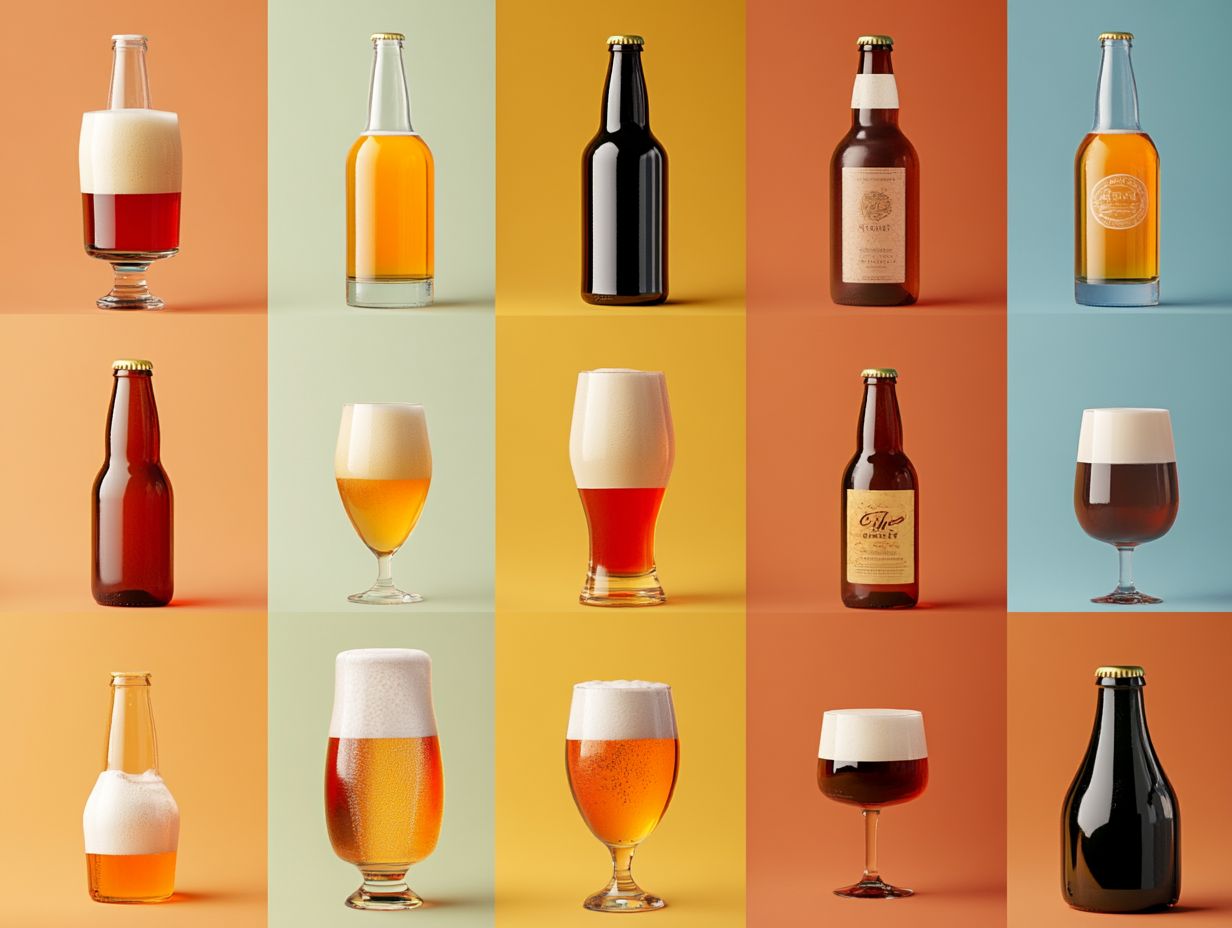
Discover the wonderful world of craft beer! For newcomers to the craft beer world, exploring American Pale Ale and Wheat Beers can be a great start. These styles offer a balanced introduction to the diverse flavors of craft beer.
The top 10 beer styles for craft beer newbies are American Pale Ale, Hefeweizen, India Pale Ale (IPA), Belgian Witbier, Brown Ale, Pilsner, Blonde Ale, Amber Ale, Porter, and Saison. You can also try American IPA and Double IPA for more variations.
What is the difference between craft beer and regular beer?
Craft beer is typically made by small, independent breweries using traditional brewing methods and high-quality ingredients. For example, Silos Brewing Company in Raleigh, NC, and Nick s of Calvert focus on craft beer production.
Regular beer, on the other hand, is made by large, commercial breweries like Budweiser and Coors Light using mass production techniques and often includes additives and preservatives.
Which beer style is best for someone who doesn’t like bitter beers?
If you don’t like bitter beers, you may enjoy Blonde Ale, Hefeweizen, or Cream Ale. These styles have a lighter, less bitter taste compared to hoppy styles like IPA, American IPA, or Pale Ale.
What is the alcohol content of these top 10 beer styles for craft beer newbies?
The alcohol content varies for each style but generally ranges from 4-7% ABV. However, some styles like IPA, Double IPA, and Saison can have a higher alcohol content of 8-9% ABV.
Are there any gluten-free options among the top 10 beer styles for craft beer newbies?
Yes, there are gluten-free options available. While Belgian Witbier is typically made with a combination of wheat and other grains, gluten-free versions can be found. Additionally, some brewers make gluten-free versions of Belgian ales like Abbey Dubbel and Belgian Tripel.
What food pairings go well with these top 10 beer styles for craft beer newbies?
Get ready to find your new favorite! The food pairings can vary depending on personal taste, but here are some general suggestions:
American Pale Ale pairs well with grilled chicken or fish.
Hefeweizen complements spicy dishes nicely.
IPA is a great choice with burgers or pizza.
Belgian Witbier works well with seafood.
Brown Ale matches perfectly with BBQ meats.
Pilsner goes well with salads or light appetizers.
Blonde Ale pairs nicely with cheese and charcuterie.
Amber Ale is a good match for Mexican food.
Porter pairs wonderfully with chocolate desserts.
Saison complements savory dishes like roasted vegetables or stews.
If you enjoy robust flavors, Porters and Stouts are perfect with hearty dishes, while Sours can refresh your palate with tangy options.

